Mbeya is a region in Tanzania known for its great diversity of birds. The country is home to over 1,000 species of birds, ranging from songbirds to raptors. Bird watching is a popular activity in Mbeya, with birders from around the world coming to witness the avian spectacle.
The region is home to some of Africa’s most spectacular bird species, including the majestic shoebill, the colourful bee-eater, and the critically endangered African grey parrot.
Other common species in the area include the African fish eagle, the black kite, and the marabou stork. With its diverse habitats, Mbeya is an ideal destination for all bird lovers.
1. Emerald-Spotted Wood Dove
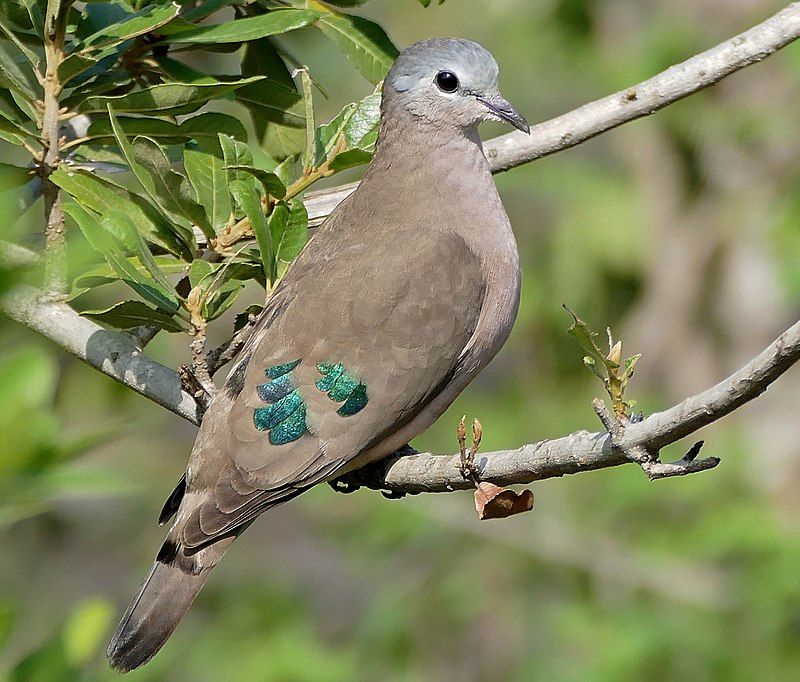
The emerald-spotted wood dove is a species of bird belonging to the family Columbidae. It is widely distributed throughout eastern and southern Africa and is commonly found in open, dry deciduous woodlands and secondary-growth forests.
The emerald-spotted wood dove does not inhabit evergreen rainforests or semi-desert areas. This species prefers open and drier habitats in order to thrive. It is able to survive on a variety of food sources, including fruit, buds, flowers, and insects.
The emerald-spotted wood dove is a small bird, measuring between 22 and 25 cm in length, with a wingspan of 34-36 cm. It is mainly grey in colour, with a pinkish-brown breast and a distinctive green spot on its head. Its flight is swift and direct.
The emerald-spotted wood dove is a monogamous species and its nest is built in a tree or shrub. Both parents take turns incubating the eggs and care for the young. This species is not considered endangered and its population is stable.
| Kingdom | Animalia |
| Phylum | Chordata |
| Class | Aves |
| Order | Columbiformes |
| Family | Columbidae |
| Genus | Turtur |
| Species | T. chalcospilos |
2. Red-Eyed Dove
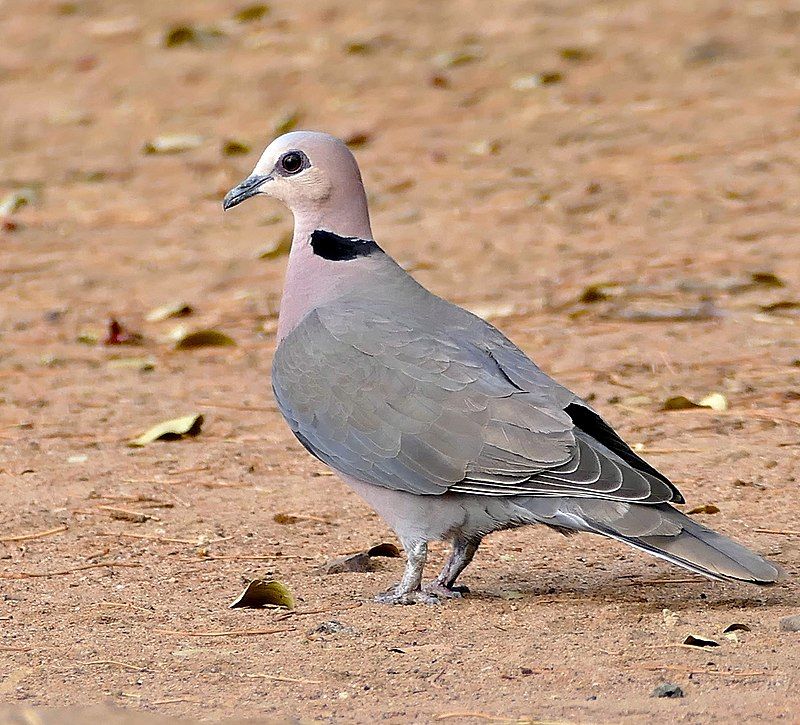
The red-eyed dove is a type of bird that is widely found throughout Sub-Saharan Africa. It is a common species in the region and its population is considered healthy and stable.
This species has been listed as Least Concern on the IUCN Red List since 2004, meaning that it is not threatened with extinction and its population is expected to remain stable for the foreseeable future.
The red-eyed dove is a medium-sized bird, measuring approximately 30 centimeters in length, with a wingspan of up to 50 centimeters. It is a grayish-brown color on its upper parts, with a white breast and belly, and a distinctive red eye.
The red-eyed dove inhabits open woodlands, savannas and grasslands, and is generally found in small groups or pairs. It is omnivorous, feeding on a wide variety of seeds, fruits, and insects.
The red-eyed dove is an important species in its ecosystem, as it helps disperse seeds and aids in pollination. It is also an important part of the food chain, serving as prey for predatory species.
The red-eyed dove is an interesting species that is an important part of the African landscape.
| Kingdom | Animalia |
| Phylum | Chordata |
| Class | Aves |
| Order | Columbiformes |
| Family | Columbidae |
| Genus | Streptopelia |
| Species | S. semitorquata |
3. Gray Heron
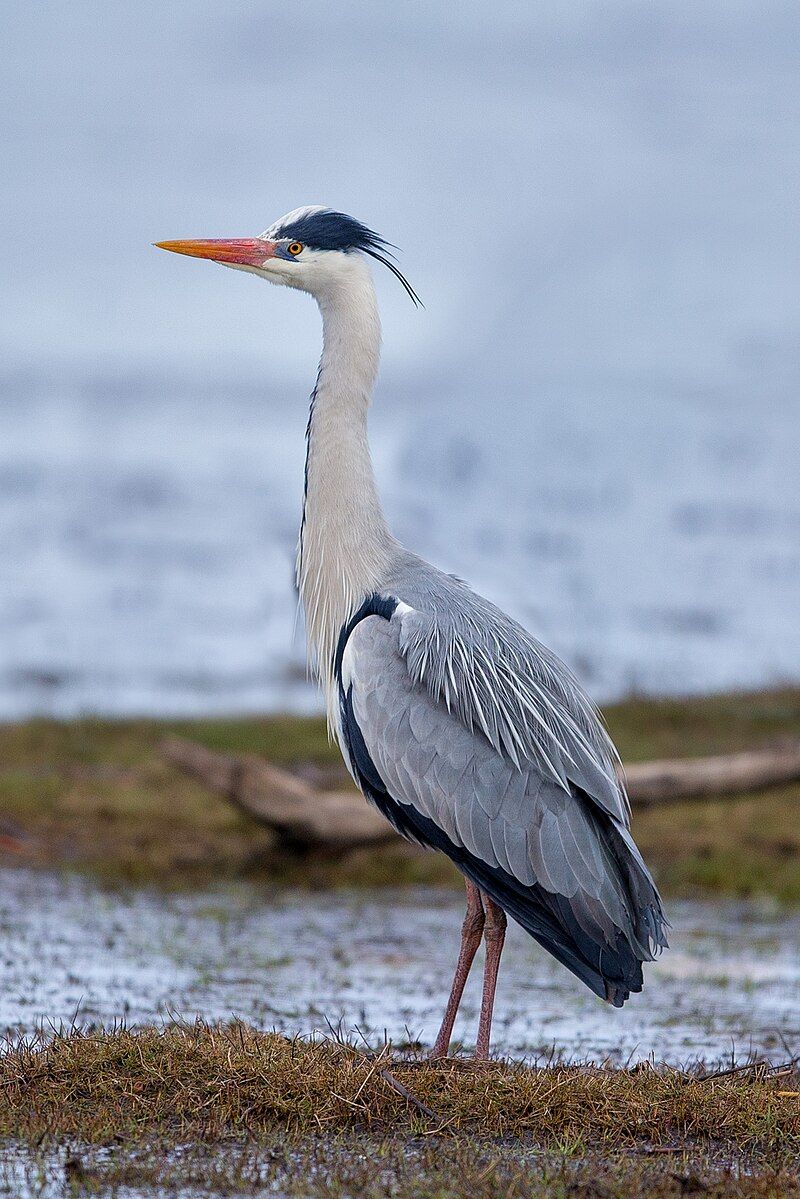
The grey heron is a well-known bird of the heron family, Ardeidae, that can be found in temperate regions all around the world, including Europe, Asia, and parts of Africa.
It has long legs that make it well-suited for wading in shallow water and uses its long beak to catch fish. This bird is normally resident in its range, however, some populations from more northern areas migrate southwards in autumn.
This is likely due to the colder weather and the availability of food sources. They often travel in groups or flocks, and make their way to suitable wintering areas. During their journey, they may stop at wetlands or other areas with plentiful food sources.
Upon arriving at their wintering area, they will often stay there until the spring when they will migrate back to their original range.
| Kingdom | Animalia |
| Phylum | Chordata |
| Class | Aves |
| Order | Pelecaniformes |
| Family | Ardeidae |
| Genus | Ardea |
| Species | A. cinerea |
4. Tambourine Dove
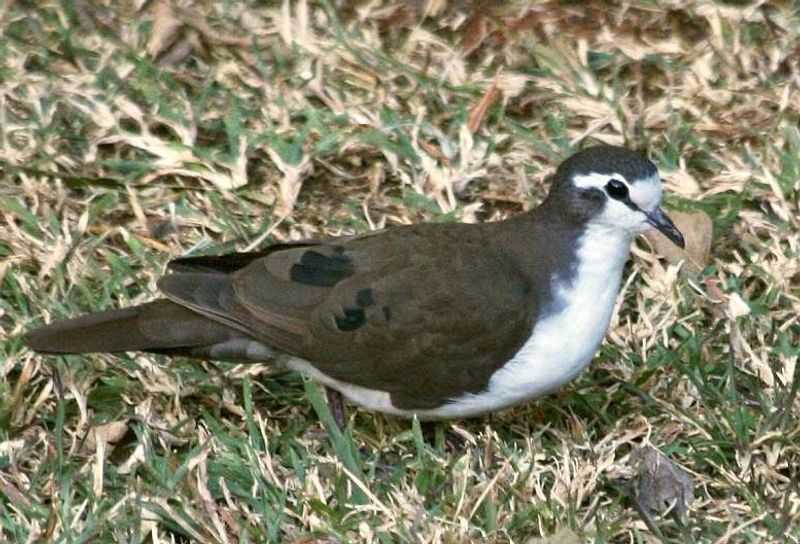
The tambourine dove is a species of pigeon found in Africa south of the Sahara Desert. It is a widespread resident breeding bird, living in woodlands and other thick vegetation.
This species of dove is known for its distinctive call, which is likened to the sound of a tambourine, hence its name. Tambourine doves are medium-sized birds, with long tails and a pointed crest on top of their head.
Their upper parts are a greyish-brown color, while their underparts are a lighter brown. They also have black and white strips along the sides of their neck and a black tail with white edges.
When in flight, they can be seen holding their wings in a V-shape, and often make foraging flights in search of food. The tambourine dove is an omnivore, meaning it feeds on a variety of food items, such as seeds, fruits, small invertebrates, and nectar.
They are also known to eat the eggs of other birds, such as weavers and widowbirds. They typically breed during the summer months, with the female laying two white eggs in a flimsy platform nest.
The female is responsible for incubating the eggs, while the male feeds her during this time. The tambourine dove is an important species in its African range, as it helps to disperse the seeds of various plants and trees, thus aiding in the regeneration of forests and woodlands.
It is also a popular target for birdwatchers, as it can be easily identified by its unique call.
| Kingdom | Animalia |
| Phylum | Chordata |
| Class | Aves |
| Order | Columbiformes |
| Family | Columbidae |
| Genus | Turtur |
| Species | T. tympanistria |
5. White-Browed Coucal
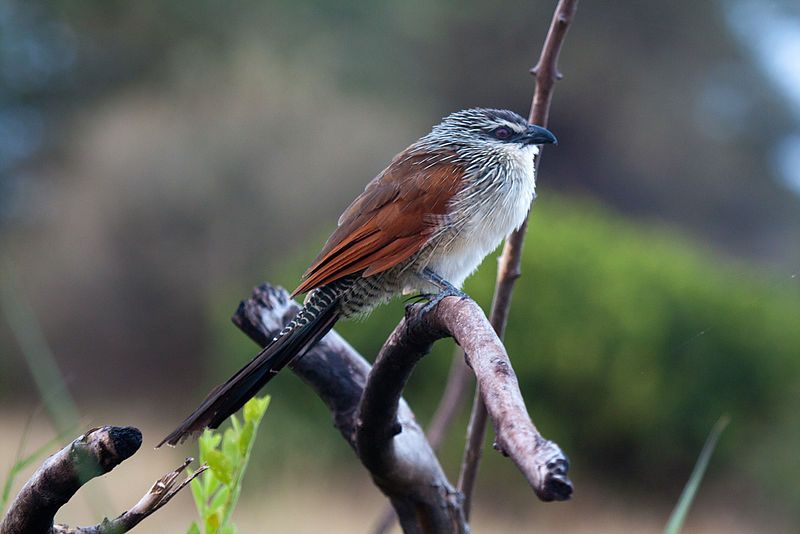
The white-browed coucal is a type of cuckoo bird found in sub-Saharan Africa. It prefers habitats with thick undergrowth and scrub, such as forests, woodlands, and coastal regions.
This species of cuckoo has a white brow and a unique call, and it is sometimes referred to as the lark-heeled cuckoo. It is closely related to Burchell’s coucal, which is sometimes considered a subspecies, though the two are very similar in appearance and behavior.
The white-browed coucal is considered a vulnerable species due to the destruction and fragmentation of its natural habitat.
Conservation efforts have been put in place in order to protect the species and its habitats, such as creating protected areas and restoring degraded land.
| Kingdom | Animalia |
| Phylum | Chordata |
| Class | Aves |
| Order | Cuculiformes |
| Family | Cuculidae |
| Genus | Centropus |
| Species | C. superciliosus |
6. Yellow-Billed Stork
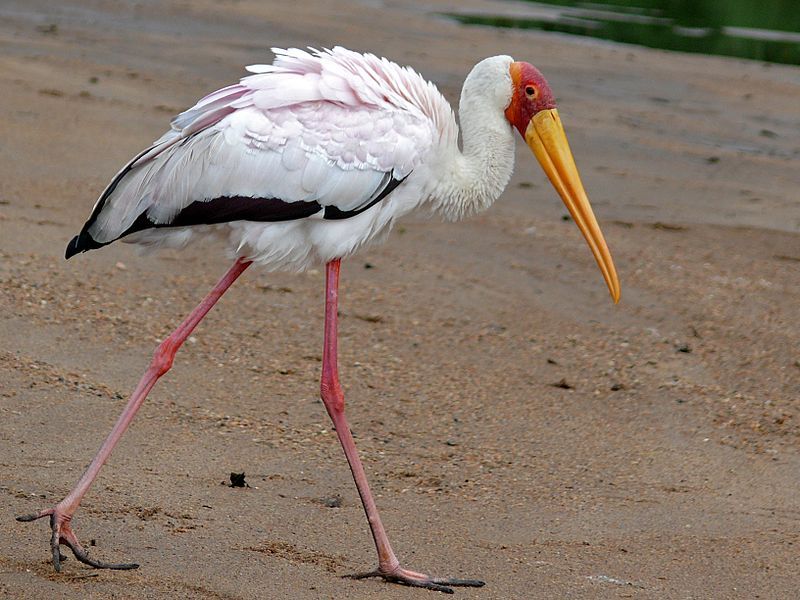
The yellow-billed stork is a large African wading bird from the family Ciconiidae. It is found in many areas south of the Sahara Desert and also on the island of Madagascar.
This species is sometimes referred to as the wood stork or wood ibis and is recognizable by its large yellow bill.
It can be found near slow-moving waters such as rivers, lakes, and wetlands, where it feeds on aquatic prey such as small fish, amphibians, and crustaceans. The yellow-billed stork is a large bird with a wingspan of up to 1.5 metres and a body length of up to 1 metre.
It has a predominantly white body with grey wings and a black tail. Its head is grey and its bill is yellow, giving it its name. Its legs are long and pink. The yellow-billed stork lives in groups of up to 12 individuals.
It builds its nest in large trees or on cliffs, and it lays one to five eggs. The female incubates the eggs for about a month before the young hatch.
The young are dependent on their parents for food for up to 6 months. The yellow-billed stork is an important species in its native African habitats, as it helps to keep the wetlands healthy by feeding on small fish, amphibians, and other aquatic organisms.
It is classified as a species of least concern by the International Union for Conservation of Nature, although its population is thought to be declining in some areas due to habitat destruction.
| Kingdom | Animalia |
| Phylum | Chordata |
| Class | Aves |
| Order | Ciconiiformes |
| Family | Ciconiidae |
| Genus | Mycteria |
| Species | M. ibis |
7. Little Grebe
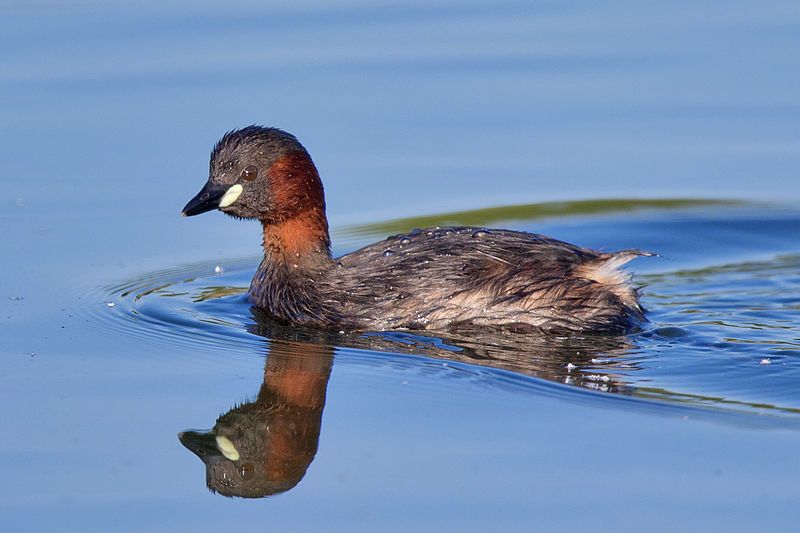
The little grebe, also known as dabchick, is a small water bird belonging to the Grebe family. Its scientific name is derived from Ancient Greek and Latin terms. The genus name, takhus, comes from Ancient Greek, meaning “fast”, and bapto, meaning “to sink under”.
The specific name, ruficollis, is composed of two Latin words. The first, rufus, translates to “red”, and the second, collis, meaning “necked”, is derived from the Latin word collum, meaning “neck”.
This scientific name thus describes the bird’s red neck, a characteristic feature of the species. The little grebe is a well-known water bird, inhabiting both fresh and saltwater habitats.
It is a swift swimmer and an agile diver, and is known to feed mainly on fish and aquatic invertebrates.
| Kingdom | Animalia |
| Phylum | Chordata |
| Class | Aves |
| Order | Podicipediformes |
| Family | Podicipedidae |
| Genus | Tachybaptus |
| Species | T. ruficollis |
8. African Green Pigeon
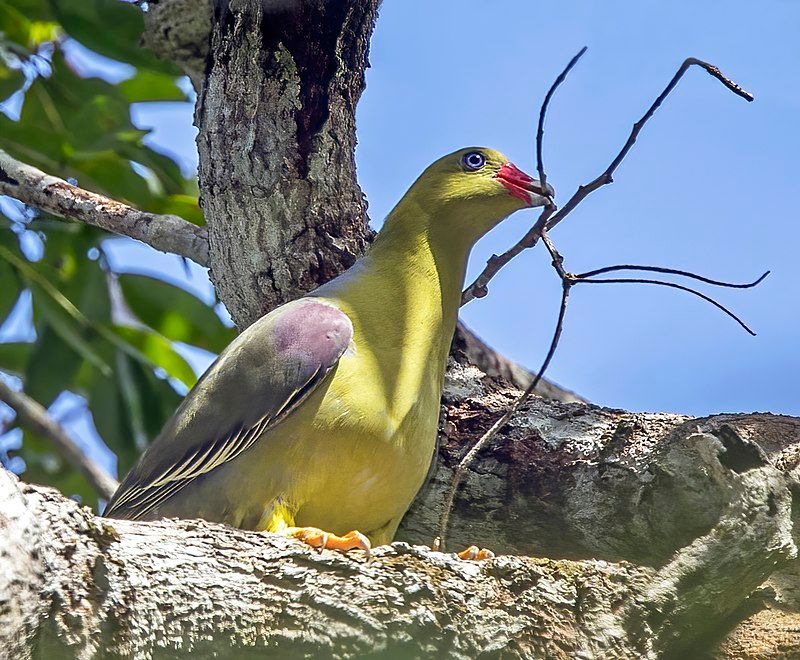
The African green pigeon is a species of bird that belongs to the family Columbidae, which also includes other green pigeon species found throughout the Afrotropics. This species has a large range of habitats in Sub-Saharan Africa, with 17 recognized subspecies.
They inhabit open savannas, woodlands, and forest edges, and can be found in many parts of the continent. They feed mainly on fruits and seeds, and are known to be quite vocal, often making loud calls in the mornings and evenings.
African green pigeons are also popular among birdwatchers, as they are easily spotted due to their bright green plumage.
Overall, the African green pigeon is an important species of bird in the Afrotropics, and its wide range and varied habitats make it an important species to protect and conserve.
| Kingdom | Animalia |
| Phylum | Chordata |
| Class | Aves |
| Order | Columbiformes |
| Family | Columbidae |
| Genus | Treron |
| Species | T. calvus |
9. Namaqua Dove
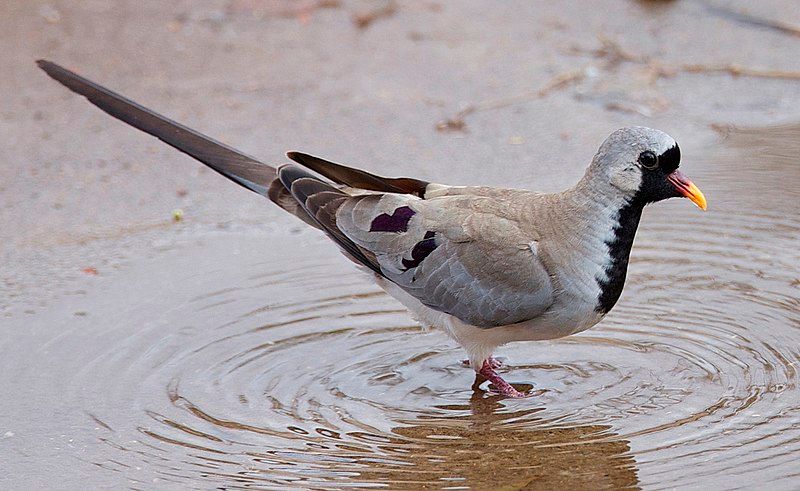
The Namaqua dove is a species of small pigeon found throughout a large portion of Africa, as well as Arabia and Madagascar. It is the only species in the genus Oena, making it a unique bird.
It has a small, compact body and is typically greyish-brown in color, with a white patch on its head and a distinctive black spot on its neck. It has a short, rounded tail and a short, straight bill. It is usually found in open woodland areas, scrubland, and grasslands.
It feeds on grasses, seeds, and insects, and roosts in trees or bushes. The Namaqua dove is a social bird, often seen in flocks of up to a hundred individuals. It is an important part of the African ecosystem, providing food for many other species.
| Kingdom | Animalia |
| Phylum | Chordata |
| Class | Aves |
| Order | Columbiformes |
| Family | Columbidae |
| Genus | Oena |
| Species | O. capensis |
10. African Jacana
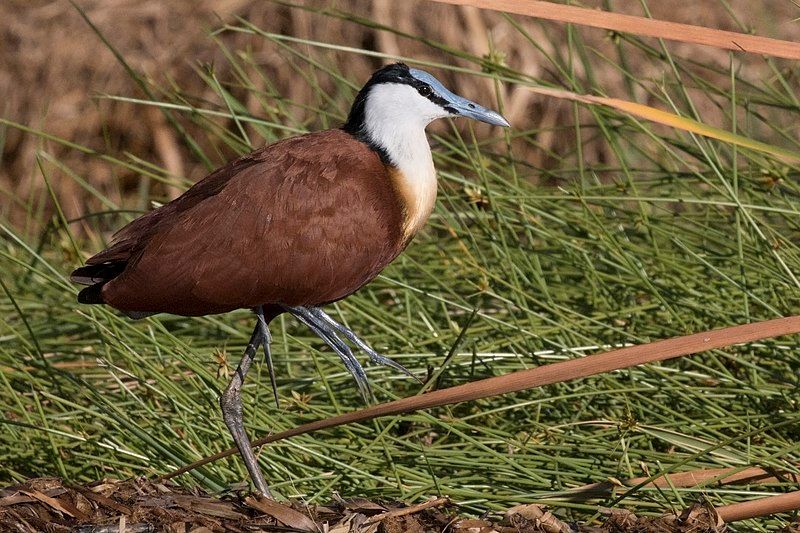
The African jacana is a type of wader, which belongs to the family Jacanidae. It lives in shallow lakes and is mainly found in sub-Saharan Africa.
This species of wader is distinguished by its long toes and long claws which allows it to walk on floating vegetation in its preferred habitat. The African jacana has adapted to its environment in order to survive.
Its long toes and claws provide the bird with the ability to easily move around on the top of floating vegetation, which is the primary source of food for the African jacana. As the jacana is able to move around on the surface of the water, it is able to find food more easily.
This is beneficial as the shallow water it inhabits is not very nutrient-rich and thus the bird needs to move around to find enough food. The African jacana is widely distributed in sub-Saharan Africa, allowing it to take advantage of different habitats and food sources.
Its claws also help it to grip onto the vegetation that it is walking on, which makes it more stable and able to traverse the water with ease.
This is important as the African jacana is a small bird and needs to be able to move around quickly in order to find food and avoid predators. In conclusion, the African jacana is an impressive wader which is adapted to its environment in order to survive.
Its long toes and claws help it to move around on top of floating vegetation and find food more easily. The African jacana is widely distributed in sub-Saharan Africa, allowing it to take advantage of different habitats and food sources.
| Kingdom | Animalia |
| Phylum | Chordata |
| Class | Aves |
| Order | Charadriiformes |
| Family | Jacanidae |
| Genus | Actophilornis |
| Species | A. africanus |
11. Harlequin Quail
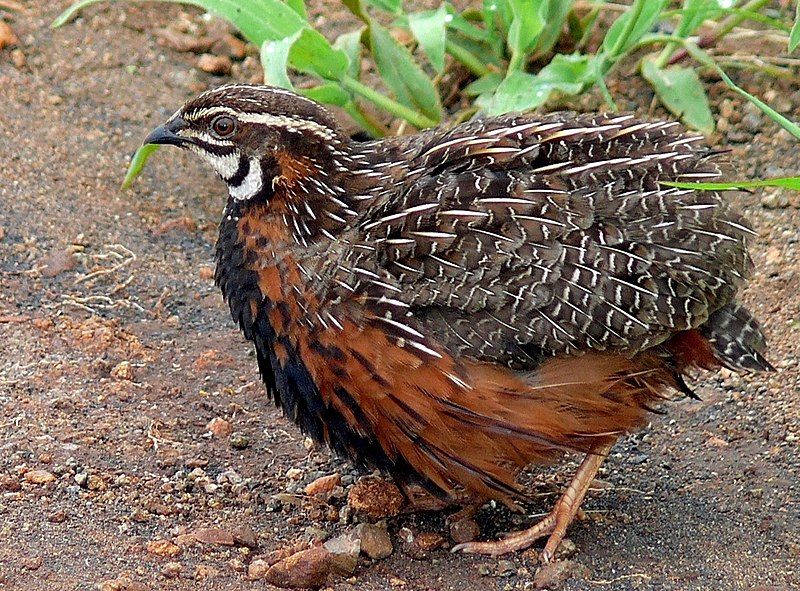
The harlequin quail is a species of bird that belongs to the family Phasianidae. This species can be found in sub-Saharan Africa and in the Arabian Peninsula. It is named after the collector, Adulphe Delegorgue, who first discovered and documented the species.
The harlequin quail has a unique look, with its colorful feathers and short, rounded wings. Its diet consists of insects, seeds, and fruits, and it prefers to live in grassland and scrubland habitats.
The harlequin quail is an important part of the ecosystem, as it helps to keep insect populations in check and spreads the seeds of plants, helping them to thrive.
Unfortunately, the species is threatened by habitat destruction and overhunting, so it is important to take steps to protect it.
| Kingdom | Animalia |
| Phylum | Chordata |
| Class | Aves |
| Order | Galliformes |
| Family | Phasianidae |
| Genus | Coturnix |
| Species | C. delegorguei |
12. White-Rumped Swift
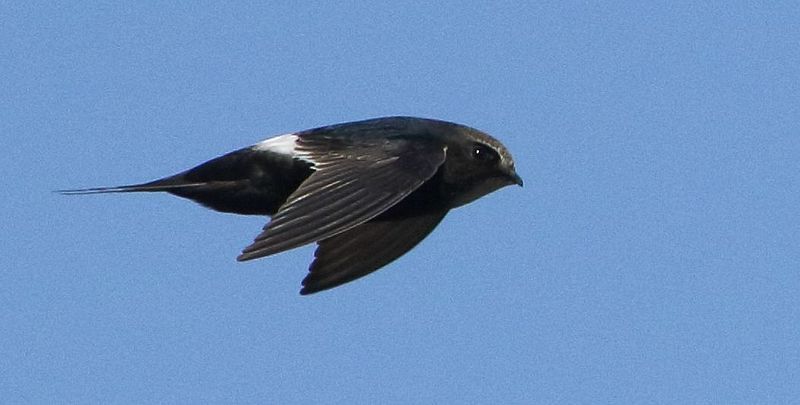
The white-rumped swift is a species of swift that is not closely related to the house martin. The similarities between the two birds come from convergent evolution, which is the process where two species become similar due to adapting to similar environments.
In this case, both the swift and the house martin are adapted to a lifestyle that involves flying and catching insects while in flight. This has led to the two species developing similar physical characteristics, despite their evolutionary differences.
Convergent evolution is an important factor in the development of species and is seen across many different kinds of animals.
| Kingdom | Animalia |
| Phylum | Chordata |
| Class | Aves |
| Clade | Strisores |
| Order | Apodiformes |
| Family | Apodidae |
| Genus | Apus |
| Species | A. caffer |
13. Yellow-Billed Duck
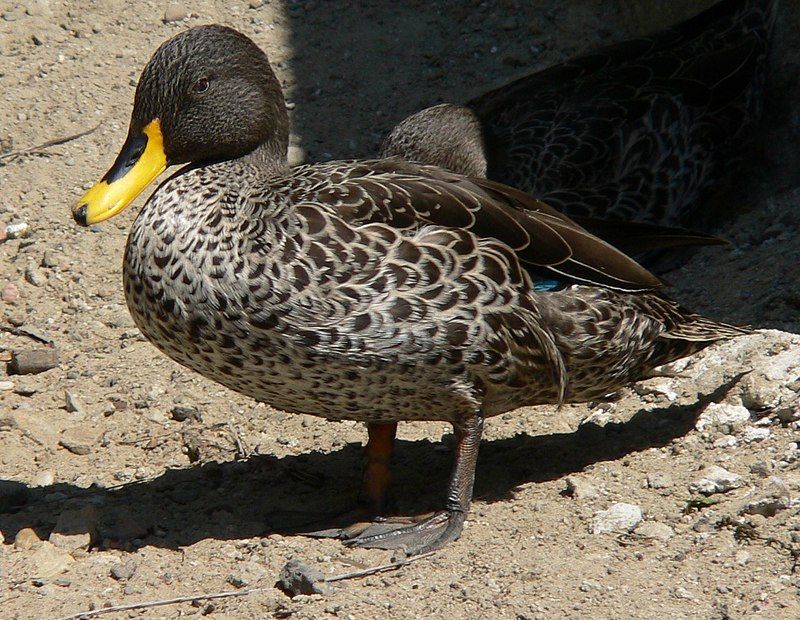
The yellow-billed duck is a species of dabbling duck found in southern and eastern Africa. It is a medium-sized bird, measuring between 51 and 58 cm in length.
This species is not migratory, but instead it wanders to different areas during the dry season in order to find suitable waters. The yellow-billed duck is a gregarious bird outside of the breeding season, and often forms large flocks in search of food and water.
These flocks can be seen in wetland areas, lakes and rivers, where the ducks feed on aquatic vegetation. The yellow-billed duck is an abundant resident breeder in its range, with pairs often nesting in large colonies.
The female builds the nest and incubates the eggs, while the male stands guard nearby. This species is highly adaptable and can be found in a variety of habitats, from marshes and swamps, to rivers, lagoons and lakes.
| Kingdom | Animalia |
| Phylum | Chordata |
| Class | Aves |
| Order | Anseriformes |
| Family | Anatidae |
| Genus | Anas |
| Species | A. undulata |
14. Blue-Spotted Wood Dove
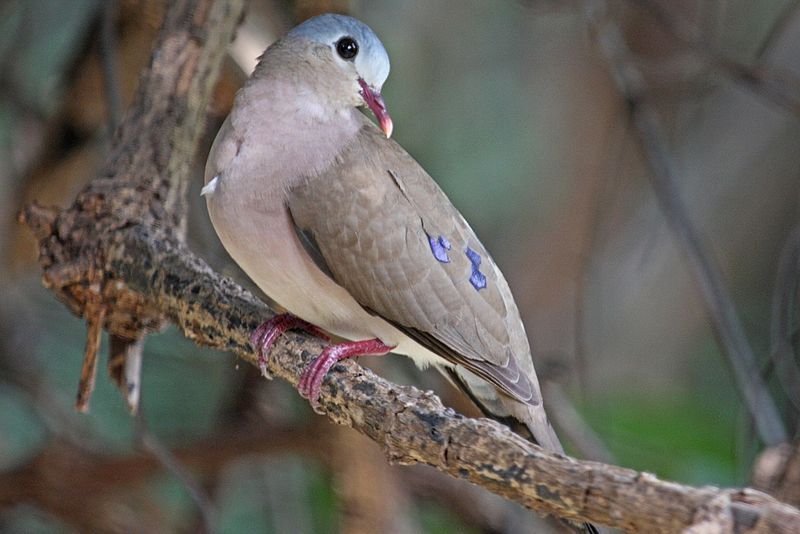
The blue-spotted wood dove is a species of bird that is found in and around the continent of Africa. It is part of the Columbidae family, which consists of doves and pigeons. This species is found in abundance throughout a large part of Africa, south of the Sahel region.
It can also be found in East Africa, but is not present in the southernmost parts of the continent. This species of bird is predominantly found in areas that are characterized by a warm and dry climate, such as savannas, grasslands, and open woodlands.
It is a medium-sized dove, with a wingspan of up to 20 inches, and has a blue-spotted pattern on its wings and body. They feed mainly on seeds, fruits, and insects, and can often be seen perched on branches or rocks, making a distinctive cooing sound.
The blue-spotted wood dove is a relatively common species of bird in Africa, and its presence helps to maintain the natural balance of the African ecosystems.
| Kingdom | Animalia |
| Phylum | Chordata |
| Class | Aves |
| Order | Columbiformes |
| Family | Columbidae |
| Genus | Turtur |
| Species | T. afer |
15. Fiery-Necked Nightjar
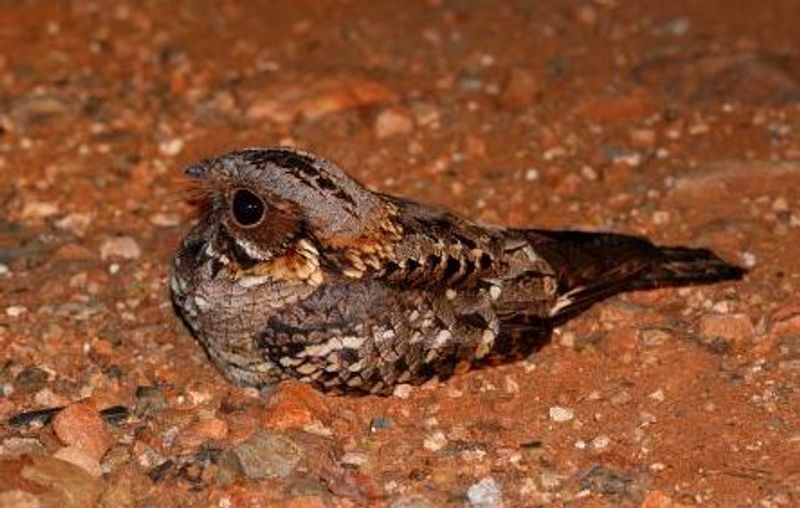
The fiery-necked nightjar is a species of nightjar that is found in Africa south of the equator. It is part of the Caprimulgidae family, which is a group of birds that are nocturnal and possess a unique call.
The fiery-necked nightjar’s call is particularly distinct and often heard in the night. It is described as a “good-lord-deliver-us” sound, signifying the bird’s characteristic sound. It is one of the most recognizable calls in the nightjar family, thus making it quite unique.
The fiery-necked nightjar is also known for its distinctively colored neck, which is a bright orange-red. This coloration serves as a warning sign for predators, as well as a way for the bird to locate other members of its species.
The species is found in many areas of Africa, and it is an important part of the ecosystem. It is an integral part of the food chain, providing food for predators and prey alike.
The fiery-necked nightjar is a fascinating species that has a special place in the African ecosystem.
| Kingdom | Animalia |
| Phylum | Chordata |
| Class | Aves |
| Clade | Strisores |
| Order | Caprimulgiformes |
| Family | Caprimulgidae |
| Genus | Caprimulgus |
| Species | C. pectoralis |
16. Spur-Winged Goose
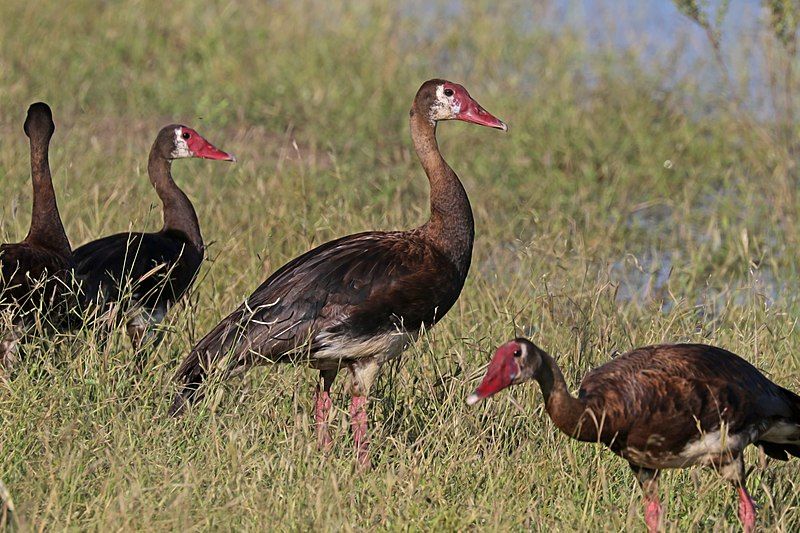
The spur-winged goose is a large waterbird that is native to Sub-Saharan Africa. It is a member of the Anatidae family, a group of birds that includes geese and shelducks. Spur-winged geese are found in shallow wetlands, such as lakes, swamps, and rivers.
They feed on aquatic plants, insects, and small fish. They breed during the wet season, with the male and female taking turns incubating the eggs. The young are cared for by both parents. The spur-winged goose is a popular game bird and is also hunted for its meat.
Its population is threatened by habitat loss, and it is listed as near threatened by the International Union for Conservation of Nature.
| Kingdom | Animalia |
| Phylum | Chordata |
| Class | Aves |
| Order | Anseriformes |
| Family | Anatidae |
| Genus | Plectropterus |
| Species | P. gambensis |
17. Greater Flamingo
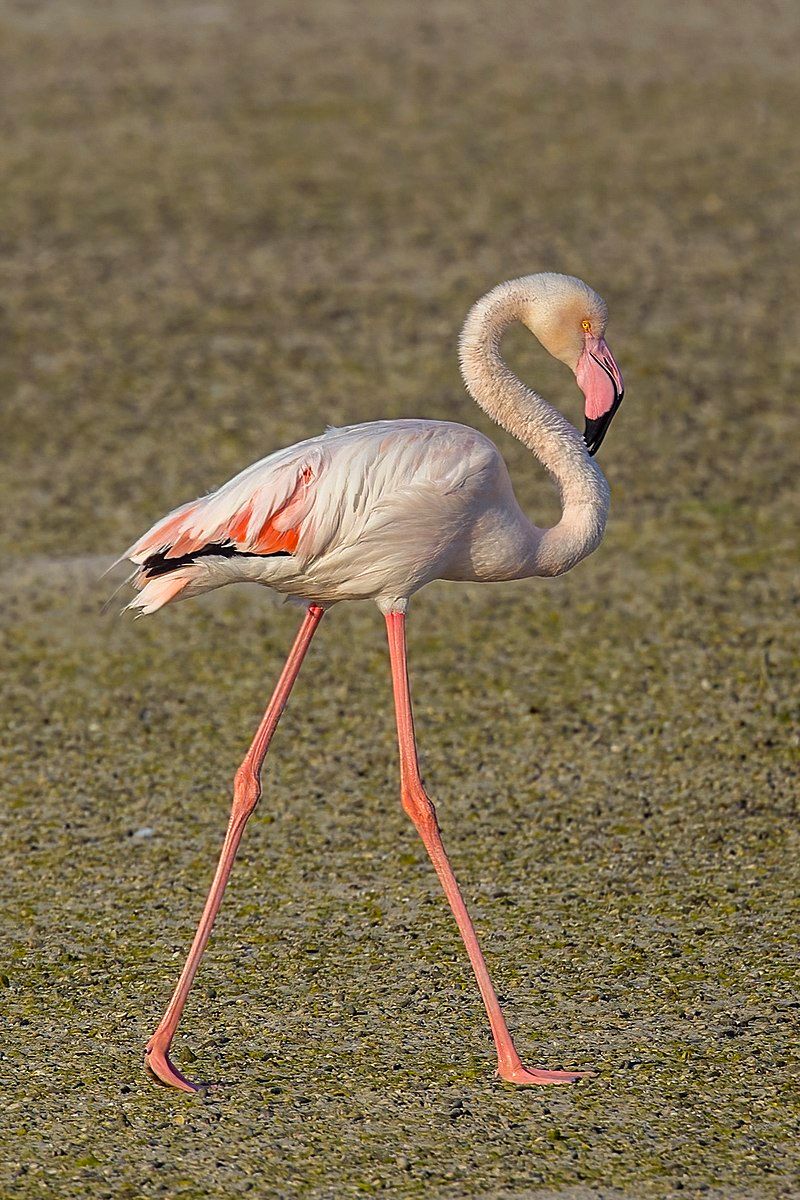
The greater flamingo is one of the most well-known species of the flamingo family, both for its size and for its wide range.
It is found throughout much of the Old World, from Northern and Sub-Saharan Africa, the Indian Subcontinent, the Middle East, the Levant, the Persian Gulf, the Gulf of Aden, the Red Sea, and the Mediterranean countries of Southern Europe.
This impressive range is due to its extensive migratory habits, as it can be found in any warm, shallow, saline water environment. The greater flamingo is an impressive bird, reaching an impressive height of up to 5 feet tall and weighing up to 8 pounds.
Its feathers are typically a bright pink, though they can vary in hue depending on diet and age.
It’s long neck and long legs are also characteristic of the species, and its large bill is specially adapted for filter feeding, allowing it to strain out tiny food items from the mud and shallow water it frequents. The greater flamingo is a social bird, typically living in large colonies of up to several thousand individuals.
In these colonies, they can be seen quietly preening their feathers, standing on one leg, and engaging in courtship behavior.
This species is also known for its impressive courtship rituals, which involve synchronized movements and loud honking. Overall, the greater flamingo is a fascinating species, with its impressive size, wide range, and impressive courtship rituals.
It is one of the most iconic species of the flamingo family, and its impressive range and presence in the Old World make it an important species to consider in the conservation of wetland habitats.
| Kingdom | Animalia |
| Phylum | Chordata |
| Class | Aves |
| Order | Phoenicopteriformes |
| Family | Phoenicopteridae |
| Genus | Phoenicopterus |
| Species | P. roseus |
18. Yellow-Necked Spurfowl
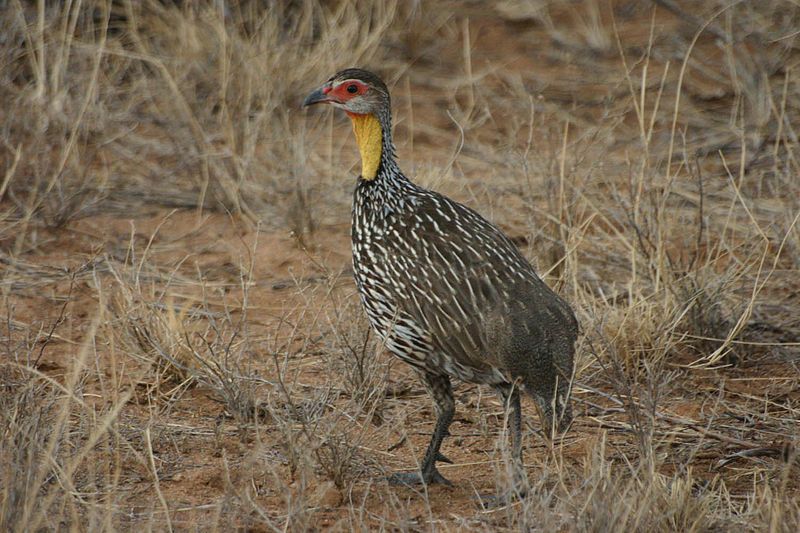
The yellow-necked spurfowl, also known as the yellow-necked francolin, is a species of bird belonging to the family Phasianidae. It is found in Djibouti, Eritrea, Ethiopia, Kenya, Somalia, Sudan, Tanzania, and Uganda.
The species is named for the yellow patch on its neck, which is a distinct feature of this bird. The yellow-necked spurfowl is a medium-sized bird, with a black and white barred pattern on its wings and a black stripe extending from its eyes to its neck.
It has a black head and a white throat, and its body is mainly brown.
The yellow patch on its neck is a distinguishing feature of this species, and it stands out against the bird’s other colors. The yellow-necked spurfowl lives in dry and semi-arid habitats, such as savannas and dry grasslands. It feeds mainly on seeds, grass, and insects.
It nests in burrows, often dug by the spurfowl itself. The bird is usually seen in pairs or small groups during the breeding season. The yellow-necked spurfowl is a common species, and it is not considered to be threatened.
However, it is vulnerable to habitat destruction and degradation, and it is listed as Near Threatened by the International Union for Conservation of Nature (IUCN). As such, it is important to protect the species and its habitats in order to ensure its long-term survival.
| Kingdom | Animalia |
| Phylum | Chordata |
| Class | Aves |
| Order | Galliformes |
| Family | Phasianidae |
| Genus | Pternistis |
| Species | P. leucoscepus |
19. Great Spotted Cuckoo
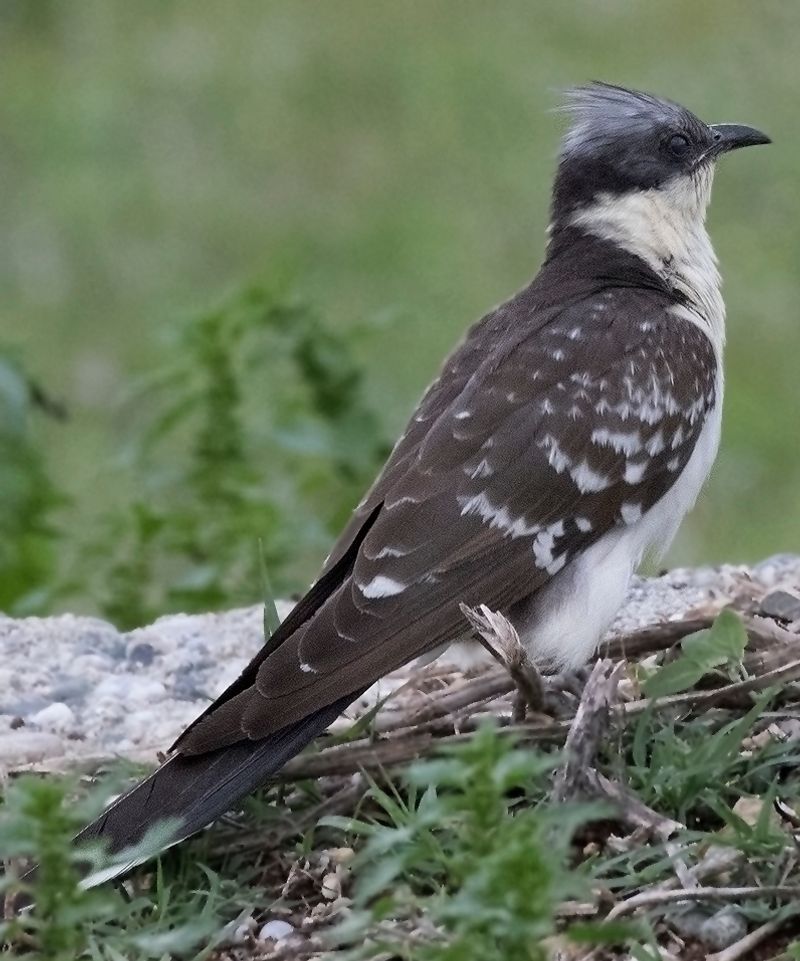
The great spotted cuckoo is a species of bird that is part of the Cuculiformes order, which includes many different types of birds such as roadrunners, anis, and coucals.
It is found in many areas in Africa and the Mediterranean Basin, and is known for its unique behavior of laying its eggs in the nests of other birds, specifically corvids such as Eurasian magpies.
This behavior is known as brood parasitism, and it is a way for the cuckoo to ensure the survival of its young. The cuckoo will lay its eggs in the nest of a host species, and those eggs will hatch faster than the host’s eggs.
The cuckoo chicks will then be more likely to survive, as the host species will often care for them as if they were their own. This behavior ensures that the cuckoo species will continue to survive, despite its limited range.
| Kingdom | Animalia |
| Phylum | Chordata |
| Class | Aves |
| Order | Cuculiformes |
| Family | Cuculidae |
| Genus | Clamator |
| Species | C. glandarius |
20. African Fish Eagle
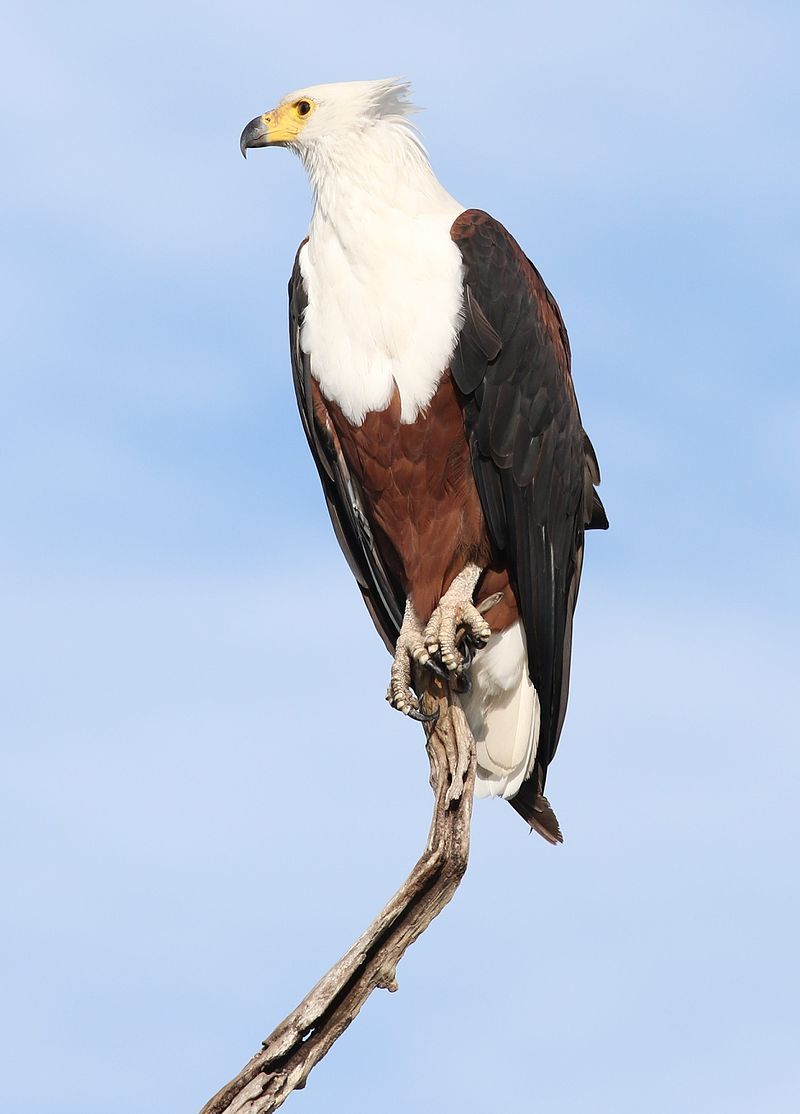
The African fish eagle is a majestic bird found throughout sub-Saharan Africa. It is a large species of eagle and is known to inhabit areas with large bodies of open water and an abundant food supply.
This species of eagle is widely respected and is the national bird of four countries: Malawi, Namibia, Zambia, and Zimbabwe. This is a testament to its prevalence and importance in the region. The African fish eagle is known by many different names in different languages.
This is due to its large range, which allows it to be seen and respected by many different cultures. It is not uncommon for it to be referred to by a different name in each country or region that it inhabits.
This diversity in language only further highlights the importance of this species of eagle. The African fish eagle is not only a symbol of national pride, but it is also an important part of the local ecology. It is a top predator and helps to keep the ecosystem in balance.
Its presence also serves as an indicator of the health of the surrounding habitat. If the bird is present, it is a sign that the environment is healthy and thriving. Overall, the African fish eagle is a majestic species of eagle with a large range and many different names.
It is an important part of the local ecology and is a symbol of national pride for many countries in the region. Its presence serves as an indicator of the health of the environment and its diversity in language highlights its importance.
| Kingdom | Animalia |
| Phylum | Chordata |
| Class | Aves |
| Order | Accipitriformes |
| Family | Accipitridae |
| Genus | Icthyophaga |
| Species | I. vocifer |
21. Great Cormorant
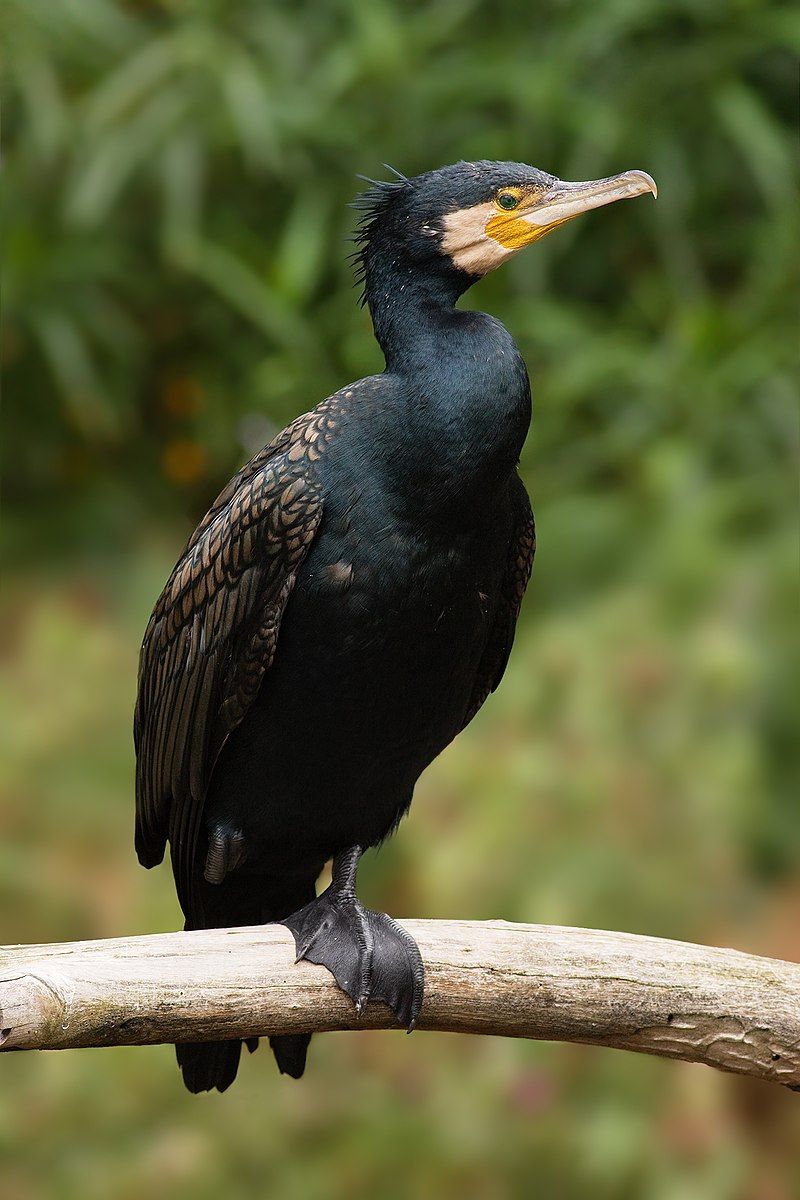
The great cormorant is a widely distributed seabird, belonging to the cormorant family of species. It can be found across the Northern Hemisphere, as well as in Australia, New Zealand, and India.
In New Zealand, it is most commonly referred to as the black shag or kawau, while in Australia it is known as the black cormorant. In India, it is referred to as the large cormorant. It is also sometimes referred to as the great black cormorant in the Northern Hemisphere.
The great cormorant is a large species, with a wingspan of up to 1.5 meters. It has a long, hooked bill and a distinctive black plumage. They typically inhabit rocky coasts and islands, where they feed on fish, small crustaceans, and other aquatic animals.
They are known to be highly social birds, and often congregate in large flocks. They are also highly adapted to aquatic life, and can dive deeply and stay underwater for long periods of time.
The great cormorant is an important species in many coastal ecosystems, and is an important food source for many larger predators.
| Kingdom | Animalia |
| Phylum | Chordata |
| Class | Aves |
| Order | Suliformes |
| Family | Phalacrocoracidae |
| Genus | Phalacrocorax |
| Species | P. carbo |
22. Black-Winged Stilt
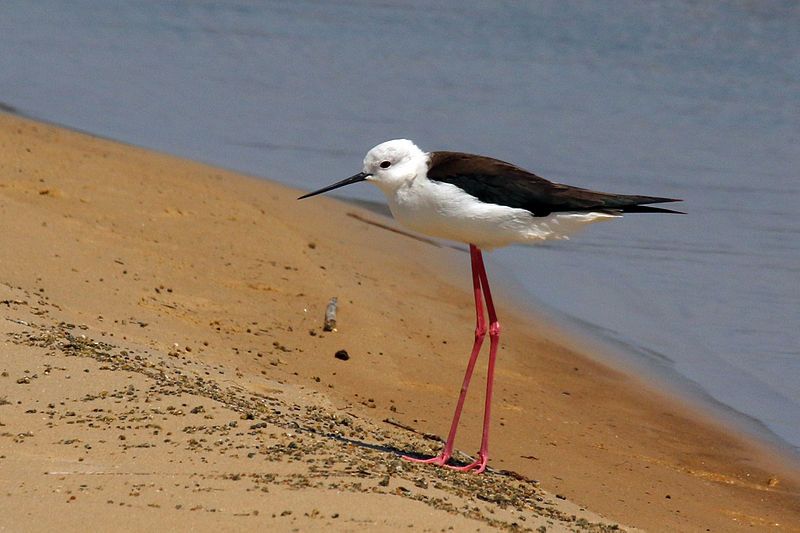
The black-winged stilt (H. himantopus) is a species of wader, which is a type of bird that primarily exists in wetland habitats. It is part of the avocet and stilt family, and is found in many parts of the world.
It is globally distributed and can be found in both tropical and temperate climates. The black-winged stilt has very long legs, and its scientific name is derived from the Greek Himantopus, which means “strap foot”.
This wader stands out from other species due to its black wings, which provide a striking contrast from its white and gray feathers. The black-winged stilt is an important member of the avocet and stilt family, and is considered to be a single, almost cosmopolitan species.
This means that the species is found in many parts of the world, and it is able to adapt to different environments.
As a result, its populations have been able to survive in a variety of different habitats, from marshes to ponds to estuaries. Due to its wide distribution, the black-winged stilt is an important part of the global biodiversity.
It helps to maintain healthy aquatic ecosystems by feeding on aquatic insects and other invertebrates. This species also provides a valuable source of food for other birds, and it is an important part of the food chain.
The black-winged stilt is an important part of the avocet and stilt family, and is an important species in the global ecosystem.
| Kingdom | Animalia |
| Phylum | Chordata |
| Class | Aves |
| Order | Charadriiformes |
| Family | Recurvirostridae |
| Genus | Himantopus |
| Species | H. himantopus |
23. Saddle-Billed Stork
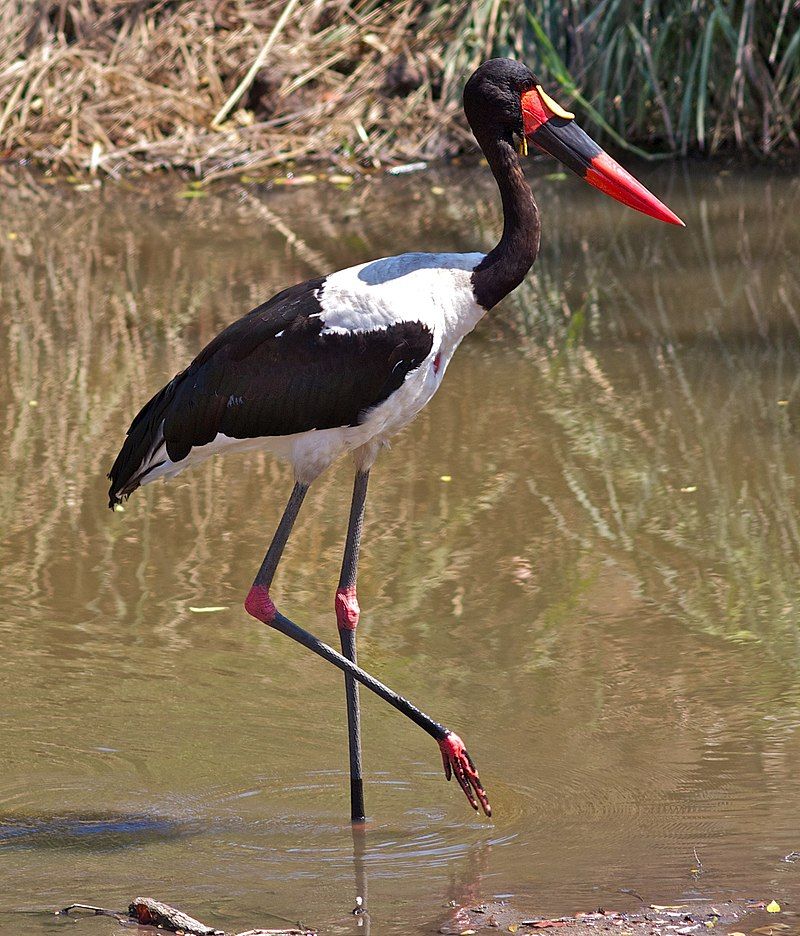
The saddle-billed stork, also known as saddlebill, is a large bird belonging to the stork family Ciconiidae.
It is widely distributed across sub-Saharan Africa, from Sudan, Ethiopia and Kenya in the east to The Gambia, Senegal, Côte d’Ivoire and Chad in the west, and from South Africa in the south to Ethiopia and Kenya in the north.
This species is a resident breeder, meaning that it lives in the same areas all year round and reproduces there. The saddle-billed stork is an impressive bird, growing to around 1.3 meters in height and boasting a colorful bill and an impressive wingspan of up to 2.4 meters.
They are typically found in shallow wetlands, such as swamps and marshes, and can often be seen in large flocks.
They feed mainly on small fish, insects, frogs, and other aquatic animals. The saddle-billed stork is a threatened species due to habitat destruction and the destruction of wetlands.
This species is also vulnerable to hunting and persecution, as it is often regarded as a pest due to its predation on small fish. Conservation efforts are underway to protect these birds and their habitats.
| Kingdom | Animalia |
| Phylum | Chordata |
| Class | Aves |
| Order | Ciconiiformes |
| Family | Ciconiidae |
| Genus | Ephippiorhynchus |
| Species | E. senegalensis |
24. Marabou Stork
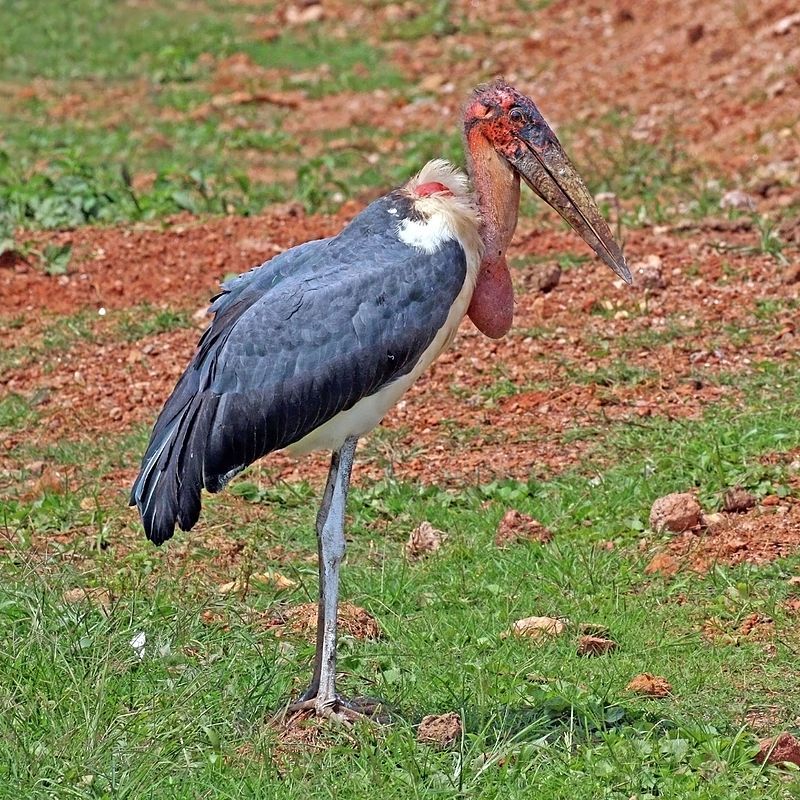
The marabou stork is a species of large wading bird native to the sub-Saharan region of Africa. It is a member of the stork family, known as Ciconiidae, and is found in a variety of habitats, from wetlands to arid regions.
The stork is often seen near human settlements, and is particularly common around landfills where there is an abundance of food. It is a large bird, with a wingspan of up to 4 feet and a weight of up to 10 pounds.
They are usually seen in flocks, and their distinctive appearance makes them easy to identify. The marabou stork is an opportunistic feeder, consuming a wide variety of food items, from fish and insects to carrion and garbage.
As a result, they are often seen scavenging for food at landfill sites and garbage dumps. The species is also known to eat eggs and chicks of other bird species, making them unpopular with some farmers.
| Kingdom | Animalia |
| Phylum | Chordata |
| Class | Aves |
| Order | Ciconiiformes |
| Family | Ciconiidae |
| Genus | Leptoptilos |
| Species | L. crumenifer |
Conclusion
Birds are an important part of the Mbeya ecosystem. They are essential to controlling insect populations, helping to disperse seeds, and providing food for other animals.
They also provide a vital link between the human communities and the natural world, playing an important role in the spiritual life of the region.
The people of Mbeya are working hard to protect the area’s bird species, and to ensure their long-term survival by creating protected areas and taking other conservation measures.